|
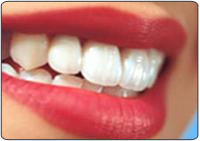 When
the outside surface (or dental crown) of one of your teeth
becomes damaged due to tooth decay or injury, we will recommend
repairing it. If tooth decay has made the tooth irreparable,
it may have to be replaced. Left untreated, a damaged tooth
might not only affect your smile, it could also lead to further
tooth decay in the underlying tooth and root, resulting in
the need for a root canal or other major dental procedure. When
the outside surface (or dental crown) of one of your teeth
becomes damaged due to tooth decay or injury, we will recommend
repairing it. If tooth decay has made the tooth irreparable,
it may have to be replaced. Left untreated, a damaged tooth
might not only affect your smile, it could also lead to further
tooth decay in the underlying tooth and root, resulting in
the need for a root canal or other major dental procedure.
Benefits of Dental Crowns
• Dental crowns protect severely damaged tooth or
tooth weakened by decay, fracture, large fillings or root
canal therapy from fracturing. Teeth with large fillings tend
to "flex more" forcing the tooth apart possibly
causing stress fractures
• Dental crowns hold together cracked or weaken teeth
and seal the tooth from decay
• Dental crowns cover discoloured teeth and irregularities
in teeth in improving cosmetic appearance
• Dental crowns help preserve the natural function and
position of the teeth
• Dental crowns restore tooth with large decay, cavities
or filings
• Dental crowns support the replacement teeth in a bridge
• Dental crowns restore and maintains natural bite
• Dental crowns acts as a false teeth over dental implants
• Dental crowns can restore your smile
 A
dental crown is one of the most effective dental solutions
for covering a tooth to restore its shape, size and strength,
or to improve its appearance. We might recommend a dental
crown to: A
dental crown is one of the most effective dental solutions
for covering a tooth to restore its shape, size and strength,
or to improve its appearance. We might recommend a dental
crown to:
- Cover discoloured teeth or dental implants
- Protect a tooth from tooth decay
- Restore a broken tooth
- Hold a dental bridge in place
The procedure for placing the dental crown involves:
Grinding the chewing surface and sides of the tooth.
Taking an impression of the prepared tooth and surrounding
teeth.
Placement of a temporary crown to cover the prepared tooth
while the permanent crown is being made.
At your second visit, we will remove the temporary crown,
check the fit and colour of the permanent crown, then cement
it in place. Dental crowns are made from a variety of dental
materials, including:
Metal (gold, nickel or chromium)
- Porcelain fused to metal
- All porcelain or all ceramic
- Resin (durable plastic)
The kind of dental crown suitable for you depends on what
which teeth need crowns.
Caring for Your Crown :
Dental crowns don't keep tooth decay at bay. You still need
to brush regularly, eat a well-balanced diet and visit the
dentist every six months. Avoiding certain habits such as
opening packages with your mouth, bruxism and chewing ice
can also help prevent dental crowns from wearing out prematurely.
If you follow these recommendations, your shiny new dental
crowns can last 5 to 15 years.
One or more missing teeth can adversely affect the appearance
and functionality of your smile. Missing teeth can cause a
change in occlusion (bite), shifting of the teeth, temporomandibular
joint disorder, speech impediments, an increased risk for
periodontal disease and a greater chance of tooth decay.
Dental bridges, like implants and partial dentures, are used
to replace missing teeth.
Dental bridges serve an aesthetic purpose, allowing you to
show off your beautiful smile without shame or fear that your
missing tooth is what people will remember. They help your
wallet, too, because dental bridges cost less than other methods
of tooth replacement.
Unlike removable devices such as dentures, dental bridge
work is cemented onto natural teeth or dental implants on
either side of a missing tooth. These anchor teeth are called
abutments. The replacement tooth -- called a pontic -- is
attached to a dental crown on each abutment.
The Dental Bridge Procedure
During the first visit, we examine the health of your gums
and other teeth to evaluate if you are a candidate for a dental
bridge. If you are a candidate for a dental bridge, you are
given a local anaesthetic so we can prepare the teeth required
to support the bridge. If the support teeth are decayed or
badly broken down, they may have to be build up before they
can be used as support teeth for a bridge.
Next, an impression of the prepared teeth with a putty-like
material is used to create a model of your teeth. Your bridge
is fabricated based on this model by a skilled lab technician
so that it precisely fits the prepared teeth. It is important
that your restoration fit perfectly to avoid additional oral
health problems such as tooth decay.
While your bridge is being fabricated, we provide you with
a temporary bridge so the teeth and gums can be protected
from damage until your permanent bridge is ready.
To complete the dental bridge procedure, you must return
to the dental office for a second visit to have the bridge
fitted and cemented.

A bridge can last more than 10 years, especially if you practice
good oral hygiene.
Remember: Dental bridge work requires healthy surrounding
teeth and gums to stay in place. To keep your teeth healthy,
brush twice a day and floss daily. Regular dental visits and
dental cleanings
are recommended twice a year.
If you have one or more missing teeth, a dental bridge procedure
might be the right dental treatment for you.
Advantages of dental bridges:
Bridges are natural in appearance, and usually require only
two visits to your dentist. If you maintain good oral hygiene,
your fixed bridge should last as many as ten years or more.
Disadvantages of having a dental bridge:
It is common for your teeth to be mildly sensitive to extreme
temperatures for a few weeks after the treatment. The build
up of bacteria formed from food acids on your teeth and gums
can become infected if proper oral hygiene is not followed.
Whether your tooth has decayed, or become injured, an all-ceramic
dental crown) is the most beautiful, precision-made and safe
solution for replacing your damaged crown. Best of all, it
looks just like your natural tooth – and is completely
metal-free.
Unlike dental crowns with a metal core, all-ceramic dental
crowns don’t show a grey line at their base near y our
gums.
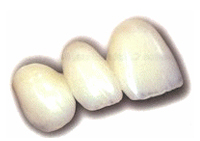
ALL CERAMIC ANTERIOR BRIDGE
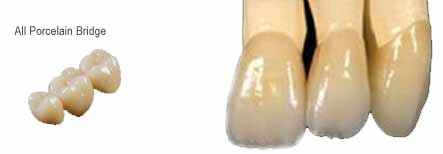
METAL FREE CERAMIC CROWNS

These are made of precious metal gold alloys and show excellent
biocompatibility and margin adaptation.
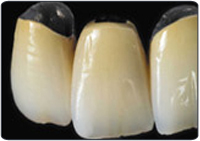 Have
underlying base metal alloys veneered with aesthetic ceramic
material to suit desired shades, and provide excellent strength.
These are economical and do not chip easily. However, the
metal may show at the margin and the underlying metal may
also affect the colour of the ceramic. Have
underlying base metal alloys veneered with aesthetic ceramic
material to suit desired shades, and provide excellent strength.
These are economical and do not chip easily. However, the
metal may show at the margin and the underlying metal may
also affect the colour of the ceramic.
Porcelain fused to metal restorations are still the most
prescribed restoratives to date. Offering several different
types of metals with which to fabricate the substructure,
a wide variety of PFM crowns and bridge solutions are available.
Advantages:
Proven effectiveness, long term durability, metal occlusion
protection, indicated for most dental restorative procedures,
wide variety of porcelains and metals available, porcelain
margins for aesthetic quality.
Disadvantages:
A porcelain-fused-to-metal (PFM) crown has a core of cast
metal alloy covered with porcelain. If your gum receded, a
gray line may become visible.
Another new and popular esthetic crown is the captek crown,
which is a combination of precious metal (gold) veneered with
ceramic, making it highly aesthetic,strong,beautiful and natural
looking.
A revitalized smile can increase your self-confidence and
enhance feelings of well-being. Captek Crowns and Bridges
are cosmetic, healthy and durable; an advanced material designed
for the patient who demands the best.
They are proven to be perfect for Achieving Vital,
Attractive Tooth Color
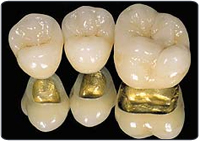 The
unique structure of the “composite metal” is the
core reason Captek’s esthetic qualities are matched
with strength, versatility and plaque resistance. Internally,
a uniquely designed skeleton of strong, stable platinum/ palladium
particles support the gold. The
unique structure of the “composite metal” is the
core reason Captek’s esthetic qualities are matched
with strength, versatility and plaque resistance. Internally,
a uniquely designed skeleton of strong, stable platinum/ palladium
particles support the gold.
No dark margins with Captek. The oxide free, warm gold color,
together with the unique light dispersion qualities of the
surface create a perfect background for porcelain that looks
vital and naturally blends in.
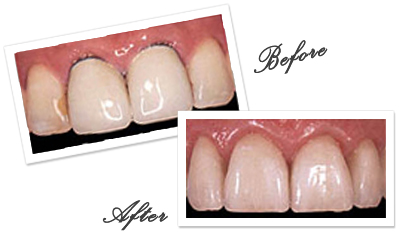
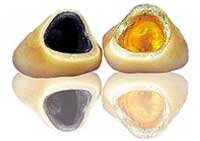
|


 When
the outside surface (or dental crown) of one of your teeth
becomes damaged due to tooth decay or injury, we will recommend
repairing it. If tooth decay has made the tooth irreparable,
it may have to be replaced. Left untreated, a damaged tooth
might not only affect your smile, it could also lead to further
tooth decay in the underlying tooth and root, resulting in
the need for a root canal or other major dental procedure.
When
the outside surface (or dental crown) of one of your teeth
becomes damaged due to tooth decay or injury, we will recommend
repairing it. If tooth decay has made the tooth irreparable,
it may have to be replaced. Left untreated, a damaged tooth
might not only affect your smile, it could also lead to further
tooth decay in the underlying tooth and root, resulting in
the need for a root canal or other major dental procedure. A
dental crown is one of the most effective dental solutions
for covering a tooth to restore its shape, size and strength,
or to improve its appearance. We might recommend a dental
crown to:
A
dental crown is one of the most effective dental solutions
for covering a tooth to restore its shape, size and strength,
or to improve its appearance. We might recommend a dental
crown to:



 Have
underlying base metal alloys veneered with aesthetic ceramic
material to suit desired shades, and provide excellent strength.
These are economical and do not chip easily. However, the
metal may show at the margin and the underlying metal may
also affect the colour of the ceramic.
Have
underlying base metal alloys veneered with aesthetic ceramic
material to suit desired shades, and provide excellent strength.
These are economical and do not chip easily. However, the
metal may show at the margin and the underlying metal may
also affect the colour of the ceramic.  The
unique structure of the “composite metal” is the
core reason Captek’s esthetic qualities are matched
with strength, versatility and plaque resistance. Internally,
a uniquely designed skeleton of strong, stable platinum/ palladium
particles support the gold.
The
unique structure of the “composite metal” is the
core reason Captek’s esthetic qualities are matched
with strength, versatility and plaque resistance. Internally,
a uniquely designed skeleton of strong, stable platinum/ palladium
particles support the gold.
